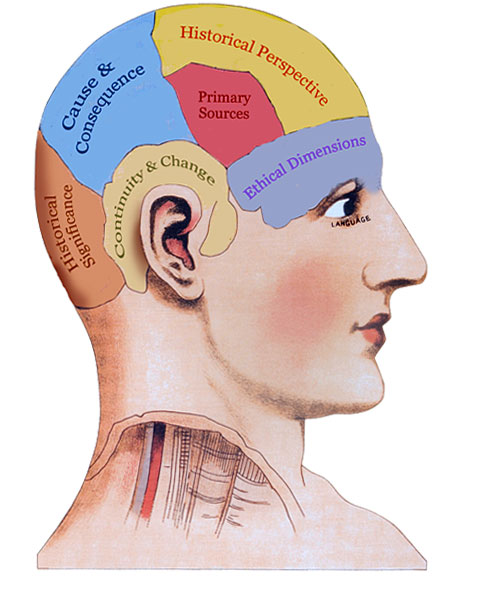Teaching Historical Thinking to B.Ed Students: What Happens?
16 October 2014 - 12:13pm
 As a new sessional instructor teaching B.Ed students, I am observing the challenges and opportunities that pre-service teachers face when they are exposed to the Historical Thinking Concepts (HTCs) for the first time. In a series of blogs, I am planning to track the introduction of the HTCs in my B.Ed course - prior to the students going out on their first teaching placements. So far, this experience has been two-fold: 1) it has allowed me to experience the strengths and limitations of my own teaching abilities, and 2) shown me where pre-service teachers need guidance and support at the beginning of their teaching careers.
As a new sessional instructor teaching B.Ed students, I am observing the challenges and opportunities that pre-service teachers face when they are exposed to the Historical Thinking Concepts (HTCs) for the first time. In a series of blogs, I am planning to track the introduction of the HTCs in my B.Ed course - prior to the students going out on their first teaching placements. So far, this experience has been two-fold: 1) it has allowed me to experience the strengths and limitations of my own teaching abilities, and 2) shown me where pre-service teachers need guidance and support at the beginning of their teaching careers.
With recent changes to the Ontario history curriculum, B.Ed students are now being taught the HTCs in the intermediate/senior history subject course. One of the interesting points in the new Ontario curriculum is the inclusion of only four of the historical thinking concepts, with the exclusion of the Ethical Dimension and Evidence. This has presented some challenges that will be addressed in a future blog post - stay tuned for that one!
Most B.Ed students have never heard of historical thinking. There was a transitional period in the first two weeks of the course where many of the students needed to “unlearn” how they where taught history when they were in high school and undergraduate university classes. Many initially struggled with the language in the new curriculum documents and needed time to figure out how the HTCs would be incorporated into daily lesson plans. This presented a challenge for me as I had previously only taught high school students and more experienced teachers in Additional Qualification (AQ) courses.
I encouraged ongoing dialogue with the B.Ed students - to ensure that they kept me up to date with their understanding of the concepts, as well as the difficulties that they encountered. Many spoke of the following possible barriers:
- uneasiness with teaching historical thinking in school placements if their associate teachers did not use the concepts from the new curriculum document
- potential anxiety when trying to teach the new curriculum in an environment that has yet to fully embrace the teaching of historical thinking.
- confusion regarding how to structure lesson plans and how to evaluate historical thinking on assignments and tests.
So, how did I address these concerns? Their introduction to critical challenges from the Critical Thinking Consortium helped to alleviate some of their concerns, and they began to get more interested in the incorporation of historical thinking and critical thinking into their daily practice. Similar to their initial introduction to the history curriculum documents, the B.Ed students had some difficultly understanding how to create a critical challenge. After several activities in class that highlighted the various parts of the critical challenge along with several examples, the students began to show more confidence and greater understanding of how important it is to engage history students and to get them to think and work like historians. An important thank you goes to Professor Ruth Sandwell (my thesis advisor at OISE and THEN/HiER board member) for sharing some valuable resources regarding the introduction and teaching of critical challenges to B.Ed students.
Professor Sandwell also recommended the two books that I have used in my classes. The first book was The Big Six by Dr. Peter Seixas and Tom Morton and the second was Teaching about Historical Thinking by Mike Denos and Roland Case. These two books have provided excellent tools and strategies to get pre-service teachers to incorporate historical thinking into their every day history teaching. I would recommend both books to anyone teaching historical thinking concepts to either teachers or students.
I expect to gain valuable feedback from my B.Ed students once they return from placement, and together, we delve deeper into the historical thinking concepts. We have only begun to “scratch the surface” and I am looking forward to better understanding my own teaching and how pre-service teachers refine their own practices at the start of their journey in this important profession.
What challenges have emerged in your experience using HTCs with B.Ed students?
References:
Denos, Mike and Roland Case. Teaching about Historical Thinking. Vancouver: Critical Thinking Consortium, 2006. http://tc2.ca/shop/index.php?main_page=product_info&cPath=1_114&products_id=3
Sexias, Peter and Tom Morton. The Big Six Historical Thinking Concepts. Toronto: Nelson, 2012. http://www.nelson.com/thebigsix/about.html
Photo credit: The Historical Thinking Project, Centre for the Study of Historical Consciousness http://historicalthinking.ca/historical-thinking-concepts

